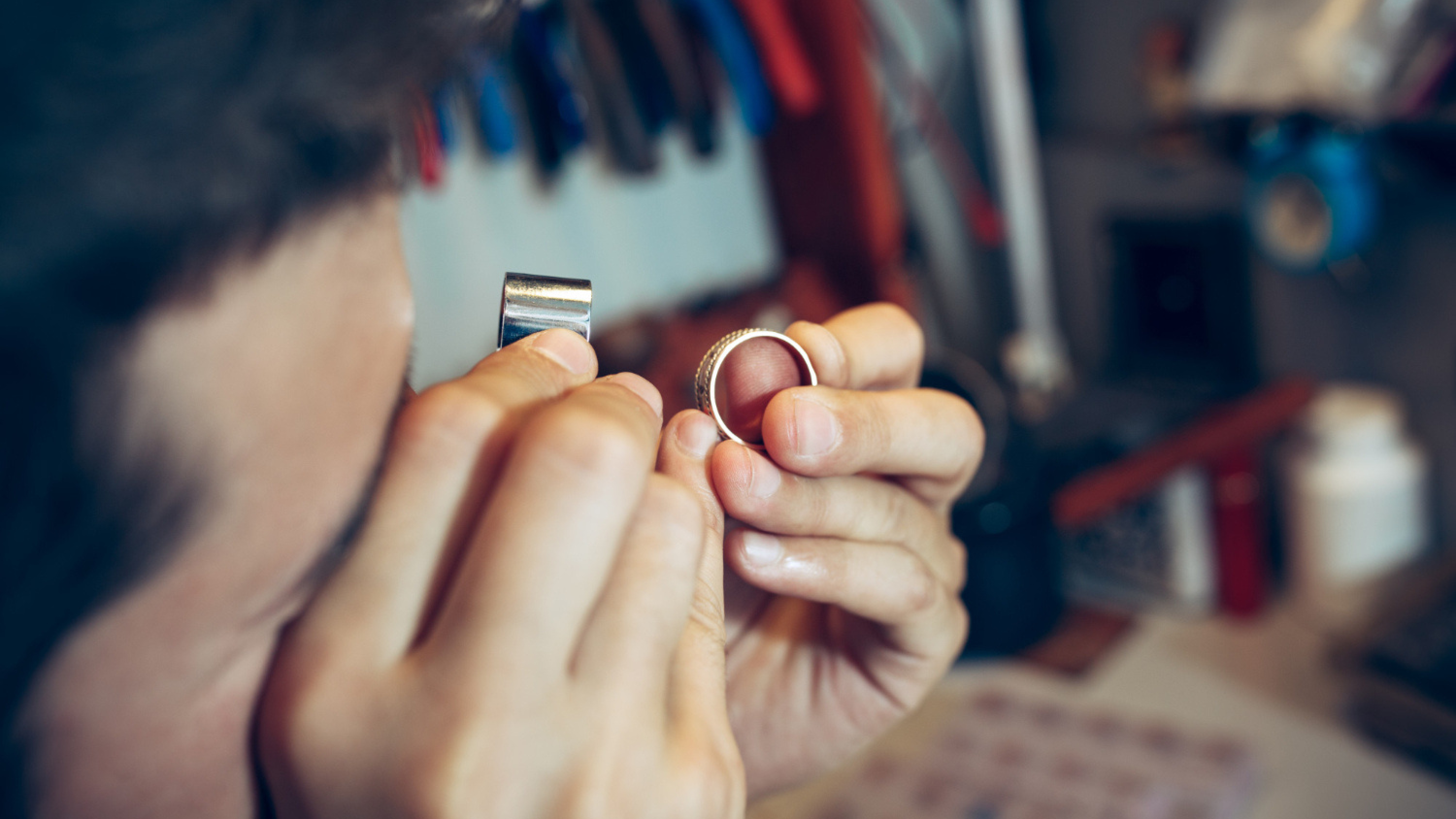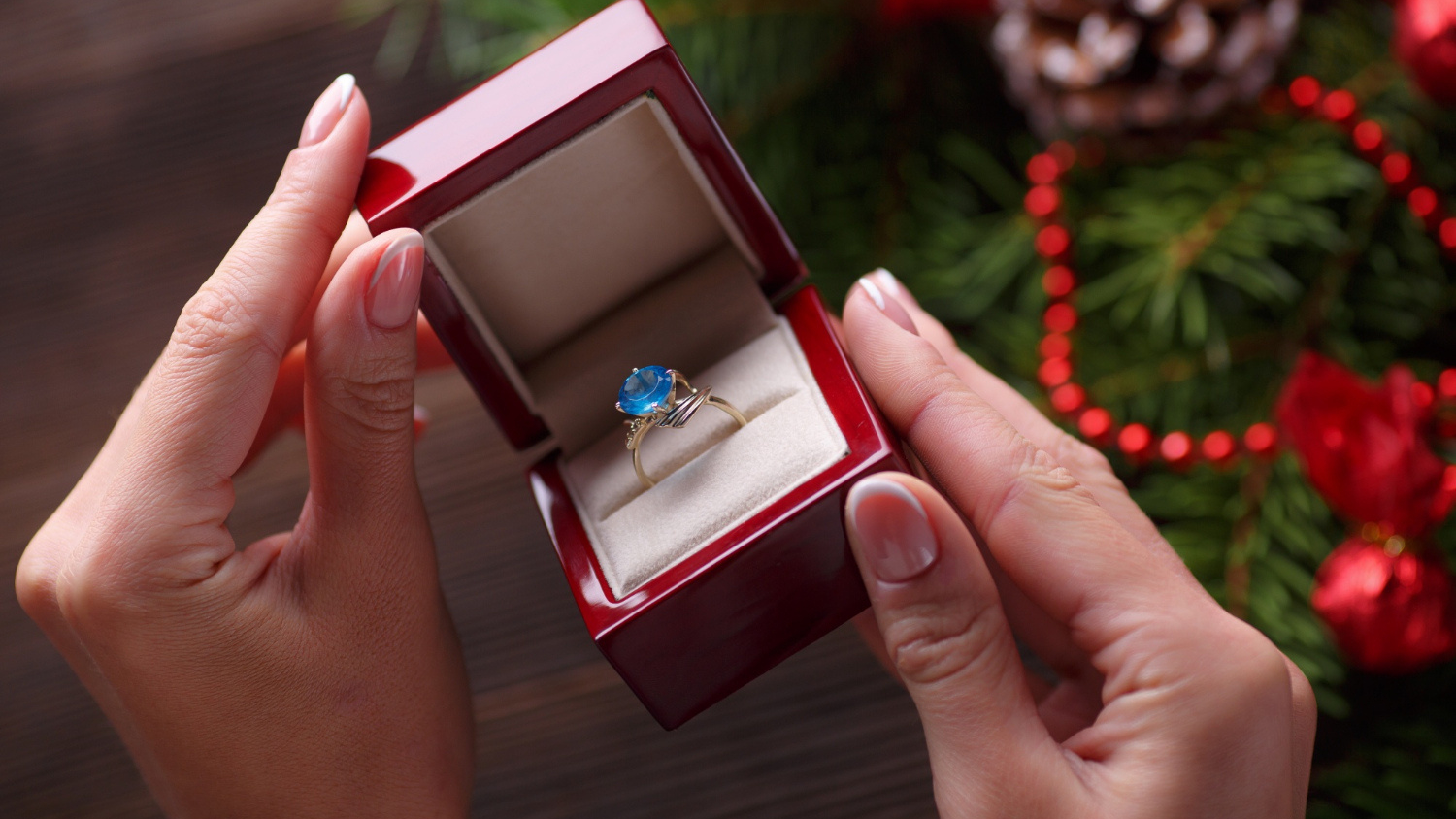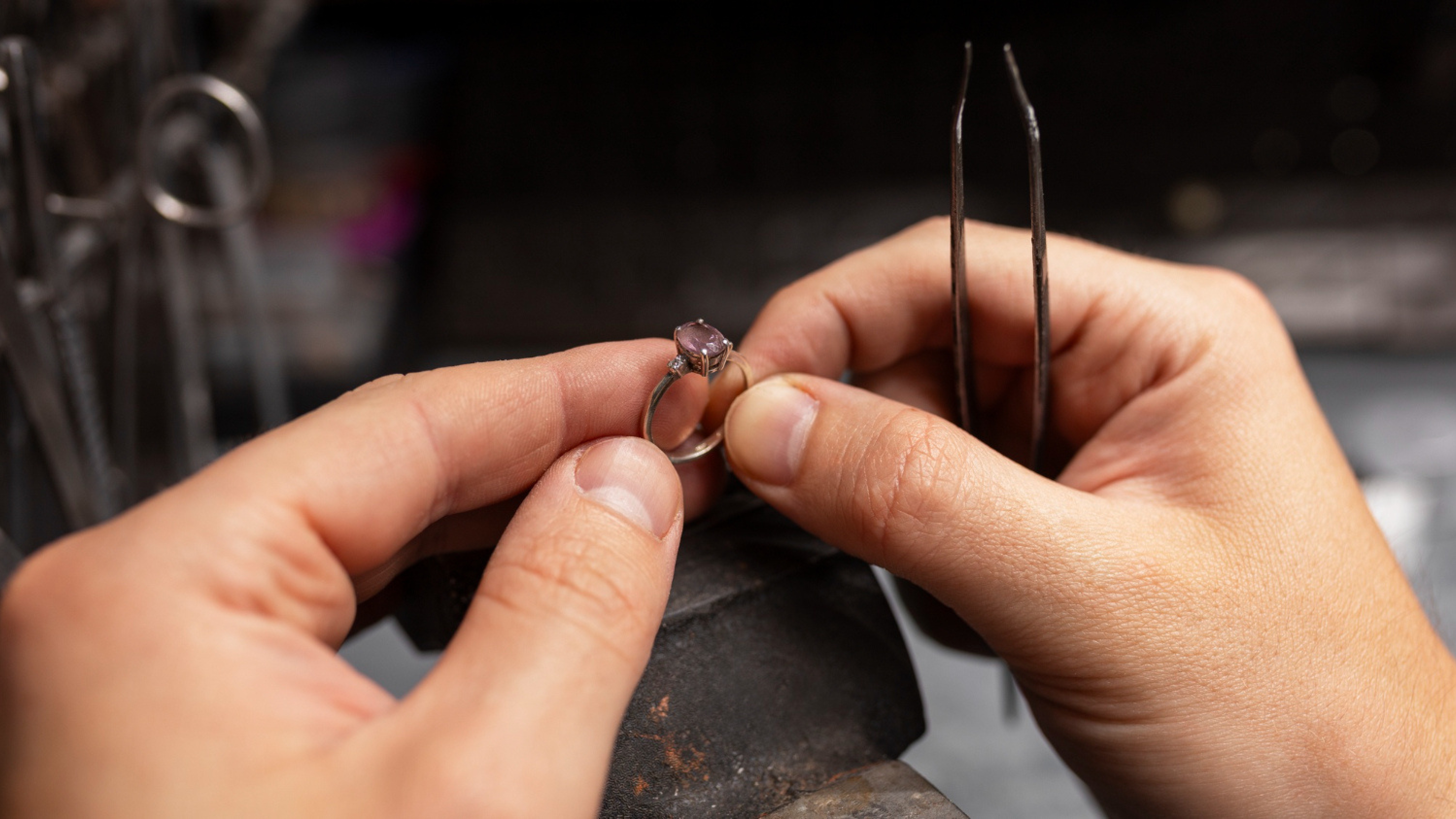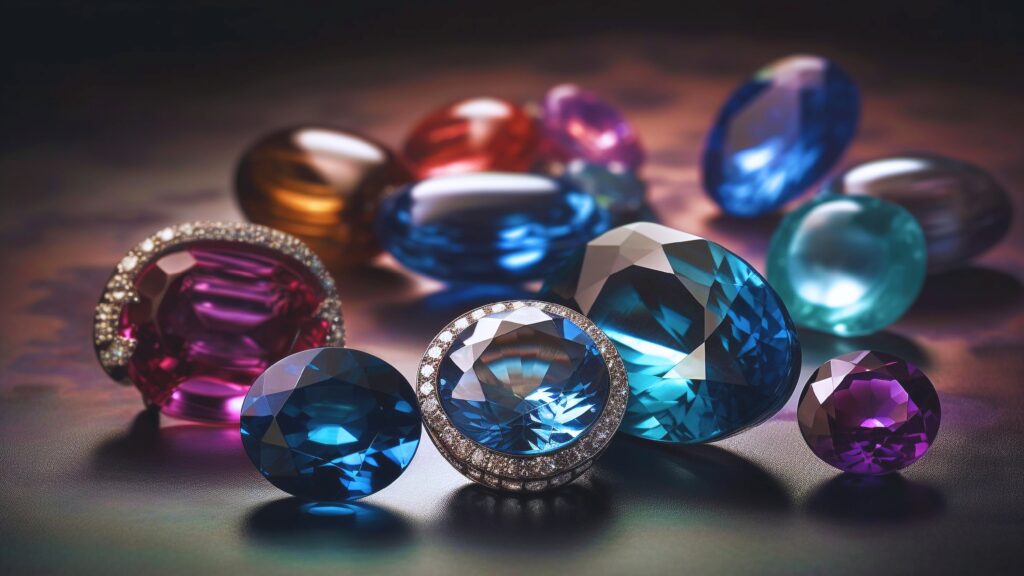Table of Contents
Caring for your jewelry is an art that helps your prized possessions last longer and look better. We’ll explore useful advice in this book that goes beyond the fundamentals.
Let’s now go over each section in more detail, adhering to the suggested structure:
Recognizing the Materials in Your Jewelry:

Explore the intriguing world of jewelry materials as we explore the subtleties involved in creating beautiful items. Knowing the material of your jewelry is essential to enjoying its beauty and guaranteeing its longevity, whether you’re looking for classic pieces or more modern favorites.
Interpreting Valuable Metals
Take a tour through platinum, silver, and other precious metals. Learn about their special qualities, robustness, and the craftsmanship that goes into turning them into exquisite jewelry. Discover the prestige of platinum, the adaptability of silver, and the ageless appeal of gold.
Gold: An Elegant Symbol
For millennia, the warm glow and malleability of gold have been associated with luxury. Discover alloys, karats, and how to differentiate between different kinds of gold.
Silver: Adaptable and Everlasting
Discover the many uses for silver, which is prized for its classic style and reasonable price. Explore the complexities of sterling silver and how it is used to create both classic and contemporary designs.
Platinum: The Pinnacle of Status
Uncover the status that comes with platinum. Learn about its resilience, rarity, and the reasons it’s the material of choice for creating remarkable, long-lasting items.
Gemstones: The Masterworks of Nature
Explore the realm of diamonds, where the artistic qualities of nature are emphasized. Every gemstone, be it colorful or diamond, has a distinct tale to tell.
Diamonds: Unending Glamor
Discover the four Cs of diamond brilliance: cut, color, clarity, and carat weight. Learn how to select the ideal diamond for your jewelry.
Colored Gemstones: An array of exquisite beauty
Honor the rainbow of hues found in gemstones. Find out about well-liked options such as sapphires, rubies, and emeralds, and gain knowledge about their importance and maintenance needs.
What Is A January Birthstone : Garnet
Tips For Caring For Jewelry Pieces

Understanding Organic Materials
Discover the allure of jewelry made of organic materials—a fusion of human creativity and the beauty of nature.
1. Pearls:
- Source: Formed inside oysters and mollusks.
- Characteristics: Naturally lustrous and comes in various shapes (round, oval, baroque) and colors (white, pink, black).
- Use in Jewelry: Often used in classic and elegant designs. Cultured pearls, produced with human intervention, are widely used for sustainability.
2. Wood:
- Source: Derived from various types of trees.
- Characteristics: Lightweight, can be carved, polished, and stained. Each piece of wood is unique with its grain pattern.
- Use in Jewelry: Popular for its natural, warm appearance. Ideal for bohemian, eco-friendly, and casual styles.
3. Bone and Horn:
- Source: Animal bones or horns (buffalo, cow).
- Characteristics: Can be carved into intricate designs. Lightweight and often has a natural, earthy color.
- Use in Jewelry: Commonly used in tribal and ethnic-inspired jewelry. Adds a rustic and organic touch.
4. Shell:
- Source: Shells from marine organisms.
- Characteristics: Diverse shapes, colors, and patterns. Often exhibits iridescence.
- Use in Jewelry: Perfect for beach-themed or boho designs. Shells are versatile and can be crafted into various shapes.
5. Amber:
- Source: Fossilized tree resin.
- Characteristics: Ranges in color from pale yellow to deep orange. May contain inclusions, such as insects.
- Use in Jewelry: Resembles gemstones. Prized for its warm color and natural inclusions. Often used in vintage or statement pieces.
6. Ivory:
- Source: Historically from elephant tusks, but due to conservation efforts, alternative sources like mammoth tusks or synthetic ivory are used.
- Characteristics: Can be carved intricately. Has a creamy-white color.
- Use in Jewelry: Traditionally used for detailed carvings in vintage pieces. However, ethical concerns have led to alternative materials being more common.
7. Tagua Nut:
- Source: Seeds from certain palm trees.
- Characteristics: Often called “vegetable ivory” due to its ivory-like appearance. Lightweight and can be dyed.
- Use in Jewelry: A sustainable alternative to ivory. Used in eco-friendly and artisanal jewelry.
8. Coconut Shell:
- Source: Outer layer of coconuts.
- Characteristics: Hard, durable, and has a natural brown color. Can be carved or shaped.
- Use in Jewelry: Adds a tropical and bohemian vibe. Often used for statement pieces.
Caring For Your Jewelry : Daily Habits

Jewelry is an investment in style and memories, not just an adornment. Developing regular maintenance routines is essential to guaranteeing that your favorite pieces stay as gorgeous as the day you purchased them. We’ll go over easy, step-by-step techniques in this article to keep your jewelry shining for many years to come
- Begin with Clean Hands:
- Wash your hands well as the first step in your regular jewelry maintenance regimen. By doing this, you can be confident that none of the oils, lotions, or dirt will get on your priceless items.
- Advice: For optimal effects, use a light soap without any smell.
- Remove Before Daily Activities:
- Take off your jewelry before doing daily tasks like exercising, cleaning, or applying cosmetics. Over time, the chemicals found in cosmetics and cleaning products might cause your jewelry to lose its luster.
- Advice: Assign a specific location where you can keep your jewelry out of harm’s way while doing these things.
- Examine your jewelry for any loose prongs or stones.
- This should be done for a few seconds. To make sure everything is secure, give them a gentle wiggle. Immediate resolution of any problems can stop more harm from occurring.
- Advice: For a closer inspection, use a magnifying lens.
- Give Them a Quick Clean:
- To get rid of any surface oil or debris, quickly clean your jewelry with a soft, lint-free cloth. This helps keep them shiny in between deeper cleanings.
- A good tip is to use microfiber towels since they are gentle on fragile surfaces.
- Store Correctly:
- To prevent scratches, store each piece apart while not in use. For silver jewelry, use anti-tarnish pouches or jewelry boxes with separate sections.
- Necklaces should be kept fastened to avoid tangling.
- Check for Tarnish (On Silver Jewelry):
- If you own any silver jewelry, make sure to periodically check for tarnish. Tarnish can be avoided before it gets worse and more difficult to remove.
- Advice: For a light cleaning, use a silver polishing cloth.
- Rotate Your Jewelry:
- Don’t wear the same items daily. By rotating your jewelry, you may lessen the wear on particular pieces and make sure that each piece has its moment to shine.
- Make a weekly rotation schedule as a tip.
- Keep Your Jewelry Away from Perfume:
- Fragrances and other sprays can dull the luster of your jewelry. To prevent direct contact, apply these cosmetics before putting on your jewelry.
- Advice: Don’t put on jewelry right away after applying; wait a few minutes.
- Secure Clasps and Fastenings:
- Verify the security of the clasps and fasteners on your jewelry. Pieces may break or go lost due to loose clasps.
- Advice: Acquire the knowledge of correctly fastening various kinds of clasps.
- Regular Professional Check-Up:
- Every six months, think about having your jewelry examined by a qualified jeweler. They are able to thoroughly clean and check your items for any underlying problems.
- Advice: Make a note of these examinations and any suggestions the jeweler may have.
How To Clean Gemstone Jewelry

An essential part of keeping your gemstone jewelry beautiful and long-lasting is cleaning it. Every gemstone has distinct qualities that call for particular maintenance. We’ll go over how to clean different kinds of diamonds in detail in this article so that your priceless stones never stop shining.
- Diamonds: Their glistening charm
- Step 1: Get a Mild Cleaning Solution Ready
- Combine some warm water with a few drops of dish soap that is mild. Steer clear of strong chemicals as they may harm the metal settings.
- Step 2: Clean and Soak
- Give your diamond jewelry a good 20 to 30 minutes to soak in the soapy water. Scrub the diamond lightly with a gentle toothbrush, being mindful of any potential dirt buildup locations.
- Step 3: Vacuum and Tumble
- After giving the jewelry a quick rinse in warm running water, gently dry with a soft cloth free of lint. Make sure all soap residue is gone because it can reduce the diamond’s shine.
- Advice: For maximum sparkle, do this cleaning every two weeks.
- Step 1: Get a Mild Cleaning Solution Ready
- Emeralds: The Radiant Greens
- Step 1: Use a Soft Cloth
- Oils are frequently used to emeralds to improve their look. To get rid of any surface debris, give them a gentle wipe with a damp cloth.
- Step 2: Gentle Soap Dispenser
- Make a solution with warm water and mild soap if necessary. Scrub the area surrounding the emerald with a soft brush dipped in the solution. Don’t use too much force to stop damage.
- Step 3: Wash and towel-dry
- After giving the emerald jewelry a quick rinse with warm water, blot it dry with a fresh cloth. Before storing, make sure the item is totally dry.
- Advice: To keep emeralds from fading, store them out of direct sunshine.
- Step 1: Use a Soft Cloth
- Sapphires: The Royal Blues
- Step 1: Use a Soft Cloth
- Make a solution by combining warm water and mild soap. To remove any grease or grime, soak your sapphire jewelry for ten to fifteen minutes.
- Step 2: Cleaning with a soft brush
- Gently clean the area surrounding the sapphire with a gentle brush, being mindful of any complex settings. Take care not to damage the metal.
- Step 3: Air dry and rinse
- After giving the jewelry a quick rinse under running water, let it air dry. Make sure that no moisture has collected in any cracks.
- Advice: Keep sapphires away from sudden changes in temperature.
- Step 1: Use a Soft Cloth
- . Pearls: The Eternal Beauty
- Step 1: Use a Damp Cloth:
- To eliminate grease and sweat, wipe pearls with a gentle, damp cloth after each wear. This keeps materials from accumulating that could tarnish its shine.
- Step 2: Water Solution with a Light Soap
- Make a mild soap and water solution if needed. Wipe each pearl with a towel that has been dampened with the solution.
- Step 3: Allow to air dry
- Before storing pearls, let them air dry entirely. Refrain from applying too much heat as this may lead the pearls to become dehydrated.
- Advice: To avoid scratches, keep pearls apart from other jewelry in storage.
- Step 1: Use a Damp Cloth:
- Opals: The Fun Colors
- Step 1: Lightly Dust
- Opals are sensitive, so clean them frequently with a soft, wet cloth. Steer clear of any chemicals or products with abrasives.
- Step2: Periodic Soap Baths
- Opal jewelry can be thoroughly cleaned by submerging it in a solution of water and mild soap. Stir the water gently and let it sit for a short while.
- Step 3: Wash and towel-dry
- Clean the opals with running water and dab dry with a gentle cloth. Opals should not be exposed to intense heat or direct sunshine.
- Apply a tiny bit of baby oil to preserve the inherent moisture in opals.
- Step 1: Lightly Dust
You can guarantee that your gemstones will continue to shine for a long time by using these specific cleaning methods. Your gemstone jewelry will continue to have the same brilliant appearance as the day you bought it with regular, moderate care.
Keeping Antique Items Long-Lived: A Classic Method
Antique jewelry has a certain charm and background that make it an invaluable addition to any jewelry collection. Care must be taken with consideration and expertise if these priceless antiques are to last a lifetime and maintain their classic appeal. We’ll go into the specifics of maintaining vintage jewelry in this article so you can keep these gems for future generations.
1. Recognizing the Materials:
Compared to modern jewelry, vintage jewelry frequently uses distinct materials. Learn about the particular materials that were utilized to make your vintage jewelry because they can all need different maintenance.
Advice: To find out what materials are in your historic pieces, do some research or speak with a jeweler.
2. Gentle Cleaning Methods:
Compared to contemporary jewelry, vintage jewelry can be more fragile. To prevent needless wear or scratches, use delicate cleaning methods, like a soft brush or cloth.
Advice: Steer clear of ultrasonic cleaners and harsh cleaners as they might damage fragile historical fabrics.
3. Steer clear of Harsh Chemicals
Cleaning product chemicals may be damaging to antique materials. To keep the jewelry looking its best, use gentle cleaning agents free of chemicals.
Advice: Use a small amount of mild soap and tepid water to make a homemade cleaning solution.
4. Keep in a Controlled Environment:
Antique items frequently react more negatively to their surroundings. Keep them out of bright sunshine, extremely high or low temperatures, and dampness.
Advice: Take into account utilizing silica gel or anti-tarnish pouches.
5. Periodic Wear Inspections:
Antique items may eventually exhibit wear. Check your jewelry often for noticeable damage, weak clasps, and loose stones. Timely restorations can stop more degradation.
Advice: A magnifying glass can be used to examine small details.
6. Speak with a Professional Jeweler:
Speak with a professional jeweler with experience working with vintage jewelry if you’re unsure or if your vintage piece needs extensive restoration. They can offer advice on appropriate maintenance and required repairs.
Advice: Look for and select a jeweler that specializes in restoring historical jewelry.
7. Refrain from Overwearing:
Because of their age, vintage items may be more delicate. To lower the chance of damage, avoid wearing them every day. Keep them for important events or times when you want to stand out.
Advice: Replicas for daily use could be developed as a way to conserve the vintage items.
8. Record and Preserve:
Maintain a thorough file of your antique jewelry, including any appraisals or certificates. Future generations might use this paperwork as a historical reference and for insurance purposes.
Advice: Take crisp pictures and store them digitally for convenient access.
9. Adequate Insurance Coverage:
Make sure your antiques are properly insured. Antique jewelry frequently has sentimental and financial worth, so peace of mind may be had by getting the appropriate insurance coverage.
Advice: Renew your insurance coverage on a regular basis to account for the increased worth of your historic items.
10. Educate Future Generations:
Teach the following generation how to take care of historical jewelry. Instill in them a sense of responsibility for the pieces’ ongoing maintenance by teaching them about the significance and history of each one.
Advice: Make a handbook about family heirlooms that tells the backstories of each antique item.
Avoiding Common Mistakes in Jewelry Care
Although taking care of your jewelry is an art, it’s simple to make mistakes that can shorten its lifespan and detract from its beauty. Let’s look at the typical mistakes you should avoid making in your jewelry care regimen so that it stays as beautiful as the day you bought it.
- Ignoring Frequent Cleaning:
- Mistake : Belief that jewelry worn infrequently needs no maintenance.
- Solution: Whether you wear your jewelry frequently or not, make sure it is cleaned on a regular basis. Even infrequently worn items can be impacted by dirt, oils, and environmental conditions.
- Mistake : Belief that jewelry worn infrequently needs no maintenance.
- Using Harsh Chemicals:
- Mistake: Use corrosive or abrasive materials to clean jewelry.
- Solution: Only use gentle cleaning agents designed specifically for jewelry. Steer clear of strong chemicals that could harm metals and gemstones, such as ammonia, bleach, and other home cleansers.
- Mistake: Use corrosive or abrasive materials to clean jewelry.
- Disregarding Storage Top Techniques:
- Mistake: Not taking the necessary safety measures when storing various kinds of jewelry together.
- Solution: To avoid scratches, store each piece apart. For silver goods, use anti-tarnish pouches; keep necklaces unclasped to prevent tangling.
- Mistake: Not taking the necessary safety measures when storing various kinds of jewelry together.
- Subjecting Jewelry to Adverse Environments:
- Mistake: Donning jewelry while engaging in activities that subject it to intense heat, direct sunshine, or caustic substances.
- Solution: Take off your jewelry before going swimming, using strong chemicals to clean, or doing any activity where the items can be exposed to extreme weather. Abrupt
- Mistake: Donning jewelry while engaging in activities that subject it to intense heat, direct sunshine, or caustic substances.
- Not Securing Jewelry While Traveling
- Mistake: Not taking the necessary safety measures when storing various kinds of jewelry together.
- Solution: To avoid scratches, store each piece apart. For silver goods, use anti-tarnish pouches; keep necklaces unclasped to prevent tangling.
- Mistake: Not taking the necessary safety measures when storing various kinds of jewelry together.
- Ignoring Inspections:
- Mistake: Not checking jewelry for loose stones, broken clasps, or other problems on a regular basis.
- Solution: Check your jewelry on a regular basis for loose parts or indications of damage. Resolving problems early on stops additional harm.
- Mistake: Not checking jewelry for loose stones, broken clasps, or other problems on a regular basis.
- Ignoring Everyday Upkeep:
- Mistake: Neglecting to establish regular routines for maintaining jewelry.
- Solution: Establish easy daily upkeep routines, such taking off jewelry before working out or using cosmetics. By doing this, needless wear and tear is avoided.
- Mistake: Neglecting to establish regular routines for maintaining jewelry.
- Ignoring the Safety of Children’s Jewelry:
- Mistake: Making the mistake of letting kids wear jewelry without thinking about safety.
- Solution: Select kid-safe jewelry and stay away from tiny bits that could be ingested. Teach kids the value of safe handling and appropriate care.
- Mistake: Making the mistake of letting kids wear jewelry without thinking about safety.
Conclusion
In summary, maintaining the longevity and beauty of your jewelry collection requires regular care and attention. Whether the materials used to create your pieces are organic, gemstones, or precious metals, a regular and thoughtful approach to maintenance can greatly increase their longevity.
Never forget that every piece of jewelry is a special investment, both financially and emotionally. You can preserve the aesthetic appeal of your collection and add to its lasting worth by taking a proactive approach to care. In the end, taking the time to take care of your jewelry guarantees that every item will keep telling its tale and bringing back the experiences and memories it symbolizes.
FAQ’s
Q. How should I clean my jewelry at home?
Use a mild soap and lukewarm water with a soft brush for most jewelry. However, consult specific care instructions for your jewelry type. Avoid harsh chemicals and abrasive materials.
Q. Can I wear my jewelry while swimming or bathing?
It’s best to avoid wearing jewelry in water, as chemicals in pools or harsh soaps can damage metals and gemstones. Chlorine, in particular, can lead to discoloration and deterioration.
Q. What’s the best way to store my jewelry to prevent tarnishing?
Store jewelry in a cool, dry place, preferably in individual compartments or pouches. Consider using anti-tarnish strips or silica gel packets to absorb moisture.
Q. What should I do if my jewelry gets scratched or damaged?
Consult a professional jeweler for repairs. Minor scratches may be buffed out, but more significant damage requires the expertise of a skilled jeweler to avoid further harm.
Q. How do I care for jewelry with gemstones?
Clean gemstone jewelry with a soft, damp cloth. Avoid exposing gemstones to harsh chemicals, extreme temperatures, or direct sunlight, as these can affect their color and brilliance.
